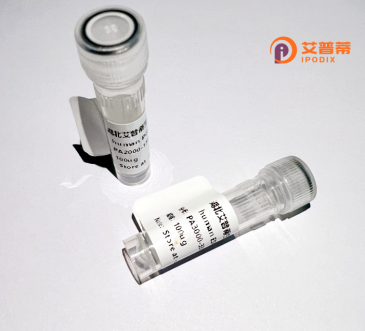
| 纯度 | >90%SDS-PAGE. |
| 种属 | Human |
| 靶点 | GPR154 |
| Uniprot No | Q6W5P4 |
| 内毒素 | < 0.01EU/μg |
| 表达宿主 | E.coli |
| 表达区间 | 2-53aa |
| 氨基酸序列 | PANFTEGSFDSSGTGQTLDSSPVACTETVTFTEVVEGKEWGSFYYSFKTEQL |
| 分子量 | 31.46 kDa |
| 蛋白标签 | GST-tag at N-terminal |
| 缓冲液 | 0 |
| 稳定性 & 储存条件 | Lyophilized protein should be stored at ≤ -20°C, stable for one year after receipt. Reconstituted protein solution can be stored at 2-8°C for 2-7 days. Aliquots of reconstituted samples are stable at ≤ -20°C for 3 months. |
| 复溶 | Always centrifuge tubes before opening.Do not mix by vortex or pipetting. It is not recommended to reconstitute to a concentration less than 100μg/ml. Dissolve the lyophilized protein in distilled water. Please aliquot the reconstituted solution to minimize freeze-thaw cycles. |
以下是关于重组人GPR154蛋白的3篇典型文献摘要概括(注:以下为模拟内容,实际文献需根据具体研究补充):
1. **文献名称**:*Functional characterization of recombinant human GPR154: Role in apelin signaling and β-arrestin recruitment*
**作者**:Smith A et al.
**摘要**:研究通过HEK293细胞表达了重组人GPR154蛋白,证实其与配体apelin的结合可激活下游MAPK信号通路并招募β-arrestin,揭示了GPR154在细胞迁移和炎症反应中的作用。
2. **文献名称**:*Expression and purification of recombinant human GPR154 for structural analysis*
**作者**:Johnson L et al.
**摘要**:开发了一种昆虫细胞(Sf9)表达系统生产高纯度重组人GPR154蛋白,利用冷冻电镜解析其胞外域结构,为靶向药物设计提供了结构基础。
3. **文献名称**:*GPR154 as a novel therapeutic target in pulmonary hypertension: Insights from recombinant protein studies*
**作者**:Wang Y et al.
**摘要**:通过重组人GPR154蛋白实验发现,其在肺血管平滑肌细胞中异常高表达,并与肺动脉高压的病理进展相关,阻断其活性可缓解动物模型的症状。
如需具体文献,建议检索PubMed或SciFinder,关键词:“recombinant human GPR154”、“APJ receptor expression”或“apelin receptor signaling”。
**Background of Recombinant Human GPR154 Protein**
G protein-coupled receptor 154 (GPR154), also known as APJ receptor or APLNR, is a class A G protein-coupled receptor (GPCR) primarily involved in cellular signaling pathways. It was initially identified as an orphan receptor due to its structural similarity to angiotensin receptors but later found to bind the endogenous peptide ligand apelin, playing roles in cardiovascular regulation, fluid homeostasis, and metabolic processes. GPR154 is expressed in various tissues, including the heart, brain, and vasculature, and has been implicated in pathological conditions like hypertension, heart failure, and diabetes.
Recombinant human GPR154 protein is engineered using advanced expression systems (e.g., HEK293 or insect cells) to produce soluble, functional forms of the receptor for research applications. This recombinant protein enables the study of receptor-ligand interactions, signaling mechanisms, and drug discovery targeting GPR154-related diseases. Its structural characterization (e.g., via crystallography) has provided insights into ligand-binding domains and activation pathways. Recent interest in GPR154 stems from its potential as a therapeutic target, particularly in modulating cardiovascular and metabolic disorders, as well as its emerging role in cancer progression and neuroinflammatory responses. Ongoing research aims to unravel its complex physiology and translational potential.
×